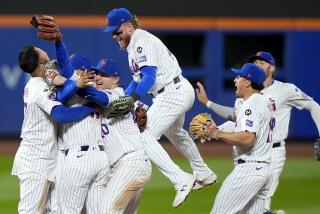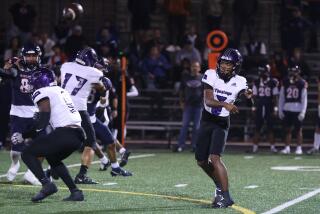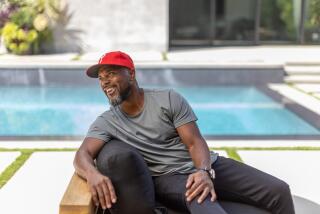METSā MARVEL : How Are They Going to Keep Greg Jefferies Down on the Farm?
MILLBRAE, Calif. ā At 20, and expected to play for the New York Metsā Triple-A affiliate in 1988, Greg Jefferies may find it difficult improving on his first two seasons in professional baseball.
Jefferies, the Metsā No. 1 draft choice in 1985, was minor league player of the year in both 1986 and 1987. A publication called Baseball America has been presenting the award for seven years. Jefferies is the first player to have won it twice.
Will he stay in Triple-A long enough to win it a third time? How long can the Mets keep him down on the farm? What position will he eventually play--shortstop, third base, second base, the outfield?
There are always questions, even with a phenom. Those are the immediate ones.
There is also this: Which is more impressive--his statistical output for 1986 and ā87, or the innovative workout routine that helped produce those statistics?
A 5-foot 10-inch, 175-pound switch-hitter who made the All-Central Coast Section teams in football and baseball during each of his last three years at San Mateo Serra High, Jefferies works out six to seven hours a day, six days a week.
He skips Sundays and recently took Thanksgiving off. Last Christmas, however, he found time to take batting practice. The normal routine begins at 9:30 a.m. and includes five different training sites:
--Throwing a football to unlimber his shoulder.
--Punching a speed bag.
--Fielding ground balls on concrete to simulate artificial turf.
--Taking regular infield practice for 25 minutes.
--Swinging a bat against a heavy punching bag.
--Hitting off a tee.
--Lifting weights at a gym.
--Jogging two miles, then sprinting up a hill 10 times.
--Swinging, under water in his swimming pool, a bat that has been sawed down the middle to create a flat side.
--Determining the color of Xs that have been painted on tennis balls as they are thrown at him in a dimly lighted gym.
--Finishing off on the treadmill he recently bought for the basement.
Said Jefferies, not at all breathless after reviewing the routine: āI love working out. I feel guilty if I miss a workout. I feel that Iāve cheated myself if Iām not physically or mentally ready when the season starts. This is what I do for a living. I might as well be the best I can at it.ā
Aimed at improving strength, bat speed and concentration, the program was designed by Jefferiesā father, Rich, a junior high school teacher and coach who played professionally in a Canadian summer league and eventually become something of an expert on the art of hitting, as well as a scout for the Chicago Cubs.
In reality, it is Jefferies and Son, they are that close. The Mets will take the son any way he comes.
Joe McIlvaine, the clubās vice president of baseball operations, citing Jefferiesā dedication and attention to detail, said: āIf ever anyone had the perfect makeup, Greg is it. He works all the time.ā
McIlvaine also said: āHeās the best young hitter ever to come along in our system.ā
No system in the last 10 years can match the Metsā for churning out quality prospects, and Jefferies may be the best yet.
At the Class-A level in 1986, he hit .339 in 26 games at Columbia, S.C., then .354 with 80 runs batted in, 43 stolen bases and 11 home runs in 95 games at Lynchburg, Va. Elevated to Double-A Jackson, Miss., near the end of the season, he had 8 hits in 19 at-bats, a .421 average.
Jefferies returned to Jackson last year and hit .367 with 48 doubles, 5 triples, 20 home runs, 101 RBIs and 26 stolen bases. He won a late season promotion to Shea Stadium and went 3 for 6.
In an era of force-feeding at the major league level, the Mets are taking it a step at a time with Jefferies for a variety of reasons. Among them:
--They figure there is no need to rush a 20-year-old.
--They remain undecided as to his best position and uncertain how to create an opening for him.
āHeās kind of a Pete Rose-type player in that heās such a good offensive player that heāll find a way into the lineup somewhere,ā McIlvaine said. āI mean, thereās probably no question about his ability to hit in the big leagues right now. Heās sure-fire. The question is, what position?ā
At shortstop, which is what Jefferies wants to play, the Mets have veteran Rafael Santana and promising Kevin Elster. At third base, they have veteran Howard Johnson and promising Dave Magadan. At second base, they have the platoon of Wally Backman and Tim Teufel.
The outfield is set with Kevin McReynolds in left, Darryl Strawberry in right and a choice between Lenny Dykstra and Mookie Wilson in center, one of whom is likely to be traded at next weekās winter baseball meetings in Dallas.
āTo some extent we have a question about Gregās ability to play 162 games at shortstop,ā McIlvaine said. āThatās not to say he canāt play the position, but we feel he needs more experience.ā
Jefferies can accept that. He played two years at third and two years at short in high school, never really working on his defense, he said, because he underestimated its importance. At Jackson last year, he made 35 errors at shortstop but said that he probably had 20 in the first month, when he was also struggling at the plate, putting pressure on himself after winning the first of his player-of-the-year awards.
āI finished second in the league in assists and third in double plays,ā he said. āI led the Carolina League in fielding the year before. I think that people overrate my fielding problems.
āIāll never be as good as Elster--heās the best Iāve seen--but I think Iāve benefited by watching him and I donāt think itāll be necessary to move to the outfield or somewhere else. At least, I hope it wonāt. Iād like to play shortstop, but itās up to the Mets. Iāll do the best I can, wherever they put me.ā
Jefferies carries the same attitude about the Metsā decision to start him in Triple-A next year.
āIād love to start in the majors, but there are a lot of great players ahead of me,ā he said. āIām also only 20. If I was 24 and coming out of college it would be different, but Iām not rushing myself.
āSometimes, guys get moved up and they really arenāt ready. Thereās so much to learn. I saw that when I was up with the Mets in September. Triple-A is probably where I belong right now. You start skipping leagues and you miss the hassles, the experiences and the education of the minors. Iāll have a lot to tell my grand kids.ā
Jefferies sat in the living room of his parentsā Millbrae home on a hill near the San Francisco airport. A steady rain clouded the panorama and forced cancellation of the outdoor phase of his training regimen.
Friendly and articulate, dark-haired and handsome, Jefferies resembles one-time Met heartthrob Lee Mazzilli. If sure-fire to hit, he also figures to be a hit on Broadway.
He is seemingly devoid, however, of the cockiness that one might expect from a player who has been All-Everything from the first time he laced up sneakers, the eventual successor to Jim Fregosi as Serraās leading baseball product, a quarterback and defensive back who eventually broke Lynn Swannās school record for interceptions.
Jefferies said he would have gone to either Arizona or Cal State Fullerton with the hope of playing both sports if he hadnāt been a first-round selection in the ā85 baseball draft.
He also said that he has never taken his ability for granted, never assumed that he had overwhelming talent. He said that he realized early that he would have to compensate for his lack of size by gaining strength, learning to use his speed on the bases and to switch-hit.
āThe greatest compliment I get now is when people watch me hit and ask if I was a right- or left-hander originally,ā Jefferies said. āWeāve worked hard to create the same swing both ways. I donāt think Iād have been a No. 1 draft choice (which got him a bonus package of approximately $100,000) if I hadnāt been a switch-hitter.ā
A natural right-hander, Jefferies began the formal transition when he was 13, though he had previously hit both ways while playing Nerf baseball with his brother Dean. Dean, now 23 and playing at the University of San Francisco, would assume the identity of Cincinnatiās Big Red Machine. Greg would employ the lineup of his favorite Dodgers, batting left-handed when Rick Monday or Reggie Smith came to the plate.
Then and now, one thing seems constant, though different people see it in different ways. Joan Jefferies, Gregās mother, calls it the Jefferies temper. Greg disagrees, saying it is strictly competitiveness. His father, Rich, uses the word intensity.
āIād try to tell him, āEnjoy it. Donāt be so hard on yourself. You donāt always have to be the best,ā ā Rich Jefferies said. āBut for Greg to enjoy it, he had to be the best. That intensity and competitive drive made him be as good as he can be. He put that pressure on himself. I mean, Iāll introduce him now at meetings or clinics and someone will inevitably say, āWait a minute, isnāt he supposed to be 6-foot-4?ā
āThe point is, he never let size or anything else stand in his way. Heās always given 100%.ā
The senior Jefferies has been there with him. Jefferies and Son. Greg laughed and said he resented it only to the extent that his mother should get the same billing, since she now has acquired a similar expertise in hitting.
It is Rich Jefferies, however, who gets the call on the infrequent occasions when Greg is struggling. Sometimes itās only a matter of calling room service, since both Rich and Joan Jefferies--given Richās freedom as a teacher and requirements as a scout--have been able to spend most of the last two summers with their young pro. They have also added a satellite dish to their backyard landscape.
This is a close-knit family whose love of baseball extends to grandfathers and uncles who played in amateur and semipro leagues and who still treat it as their special hobby, a bond when they are all together, the favorite subject when they are hunching over the pool table in the downstairs den.
Greg Jefferies, who neither drinks nor smokes and tends to avoid movies because he feels they are bad for his eyes, said he loves to play in front of his family, to have them with him. He said he hopes that he doesnāt let them down, which seems unlikely.
He has been compared to Rose in hustle and hitting style, a compliment he savors in that the pictures on his bedroom wall are those of Rose and Ty Cobb, his idols, brethren in aggressiveness.
Jefferies said he hopes to be the type hitter who is always at .300 or more with a lot of doubles and a fair number of home runs.
āI donāt want to just hit four or five a year,ā he said. āHome runs are fun, which is why Iām working so hard to improve my bat speed and strength. I hit 11 (at Lynchburg) my first year and people said Iād be the type whoād hit 10 to 15 a year. Then I hit 20 and theyāre suddenly saying Iām the type whoāll hit 30 to 40 a year.
āI donāt know about that. I do know that Iāve hit pretty well everywhere Iāve played and that Iād never be satisfied hitting less than .300, considering how hard I work.ā
Jefferies smiled and said he loved the attention created by his player-of-the-year awards, though the recognition factor may be out of hand. He wore a trench coat and dark glasses while attending the races with his girlfriend at Bay Meadows the other day and still was asked for autographs.
Does it all create a measure of pressure?
āI donāt think so because I donāt live in the past,ā he said. āIām satisfied with what Iāve accomplished, but I donāt feel Iām good enough to sit back and coast. I mean, pressure is nothing new. I put it on myself.ā
Just in case, however, Jefferies and Son have set Dec. 12 as the date for putting last season behind them and begin getting mentally ready for 1988.
Physically? Thatās already a full-time job.
More to Read
Go beyond the scoreboard
Get the latest on L.A.'s teams in the daily Sports Report newsletter.
You may occasionally receive promotional content from the Los Angeles Times.










